![]()
![]()
![]()
Use LEFT and RIGHT arrow keys to navigate between flashcards;
Use UP and DOWN arrow keys to flip the card;
H to show hint;
A reads text to speech;
53 Cards in this Set
- Front
- Back
|
What is the normal volume of pericadial space?
|
15-50ml
|
|
|
Parietal or visceral pericardium?
- fibrous |
parietal
|
|
|
Parietal or visceral pericardium?
- serous |
visceral
|
|
|
Functions of pericardium.
|
- maintains heart in relatively fixed position
- reduce friction between heart and surrounding organs - barrier against spread of infection - prevent sudden dilation of cardiac chambers during volume loading |
|
|
What is this disease?
chest pain: - sharp, stabbing - relieved by sitting up, aggrevated by deep inspiration and coughing or recumbency - dyspnea - fever |
acute pericarditis
|
|
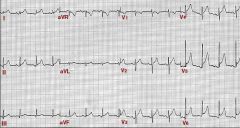
Interpret this ECG.
|
acute pericarditis
- ST elevation, PR depression (see v2-v6) - T wave inverted after ST normalized (see v1) |
|
|
How to treat acute pericarditis?
|
- bed rest
- NSAIDs: ASA - steroid only if relapsing - treat etiology |
|
|
Etiology of acute pericarditis.
|
- 90% viral
- MI - connective tissue disorder - uremia - drug induced (serous) |
|
|
What is this disease?
pericardial frictional rub - high pitch, scratchy, leathery - best heard during expiration - inconstant |
acute pericarditis
|
|
|
Etiology of pericardial effusion.
|
- viral, idiopathic
- neoplasms - infections (TB, bacterial) - uremia |
|
|
What is this disease?
physical exam - muffled heart sound - Ewarts sign: dullness to percussion, egophony |
pericardial effusion
|
|
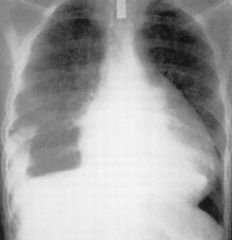
What is this disease?
|
pericardial effusion
- "water bottle" heart |
|

What is this disease?
- dyspnea, cough, hoarseness - dysphagea - sense of abdominal fullness - see above ECHO |
pericardial effusion
- compression on esophagus and trachea |
|
|
What is this disease? Etiology?
- ECHO: exudates in pericardial spave |
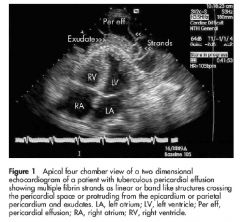
percardial effusion caused by TB
|
|
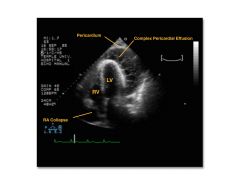
What is this disease? etiology?
|
pericardial effusion caused by bacterial infection
|
|
|
When should to drain fluid in pericardial effusion?
|
- if there is cardiac temponade or infection
- if large effusion (>20ml) for more than 1 month or right sided collapse |
|
|
Etiology of cardiac temponade.
|
- neoplasm
- uremia - viral or idiopathic - post MI rupture |
|
|
What is this disease?
- decreased arterial pressure - increased venous pressure - quiet/distant heart sound |
cardiac temponade
- Beck's triad |
|
|
What is this disease?
- pulsus paradoxus: pulse becomes stronger during expiration and weaker during inspiration. Heart beat present but no radial pulse. - Becks triad |
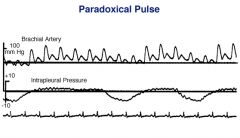
cardiac temponade
|
|
|
What can cause pulsus paradoxus?
|
- cardiac temponade
- COPD - pulmonary embolism - constrictive pericarditis - cardiogenic shock - restrictive cardiomyopathy |
|
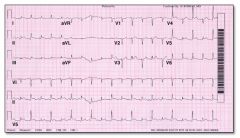
Interpret this ECG.
|
cardiac temponade
- elestrical alteransL QRS amplitude alternates (swinging of heart) |
|
|
What is the treatment for cardiac temponade?
|
- pericardiocentesis
- IV fluids and pressor agents |
|
|
Etiology of constrictive pericarditis.
|
- viral or idiopathic
- post trauma, post cardiac surgery - neoplasm - radiation - TB (in AIDs patients) |
|
|
What is this disease?
- chronic edema, wt gain - dyspnea, fatigue - hepatomegaly - Kassmaul sign: jugular venous pressure increase when deep breath - pericardial knock |
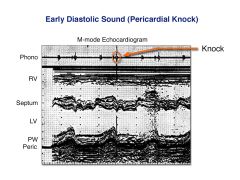
constrictive pericarditis
- figure shows pericardial knock |
|
|
What is this disease?
- ECG: wide bifid p wave in sinus rhythm - x-ray: calcification of pericardium - ECHO: thickened pericardium |
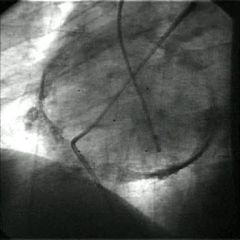
constrictive pericarditis
- figure shows calcification of pericardium |
|
|
What is the treatement for constrictive pericarditis?
|
pericardiectomy
|
|
|
What is this disease?
- equal end-diastolic pressure - RV diastolic pressure <50mmHg - ratio of RV end-diastolic pressure to RV systolic pressure > 0.33 - height of LV rapid filling wave >7mmHg |
constrictive pericarditis
|
|
|
What is this disease?
- LV end-diastolic pressure is 5mm greater than RV end-diastolic pressure - RV diastolic pressure > 50mmHg - ratio of RV end-diastolic pressure to RV systolic pressure < 0.3 |
restrictive cardiomyopathy
|
|
|
What is this disease?
- carditis - migratory polyarthritis - fever |
Rheumatic fever (JONES criteria)
|
|
|
How to treat acure rheumatic fever?
|
- PCN for 10 days
- daily PCN prophylaxis |
|
|
How to treat chronic rheumatic heart disease?
|
- for CHF: digoxin, diurectics
- for arthritis: high dose salisylates (ASA-like drugs) - bed rest |
|
|
Pathogenesis of chronic rheumatic heart disease.
|
Group A strep infection (upper respiratory tract) at age 5-15 -> acute rheumatic fever -> chronic rheumatic heart disease
|
|
|
Etiology of mitral stenosis.
|
- rheumatic valvular disease (most common)
- congenital - malignant carcinoid - amyloid |
|
|
What is this disease?
Symptoms - dyspnea - pulmonary edema - atrial fibrillation - chest pain |
mitral stenosis
- dyspnea: reduced compliance of lung - pulmonary edema: backed pressure to pulmonary arteries from LA - atrial fibrillation: cause more edema (increased LA to LV pressure gradient due to increased HR) - chest pain: RV HTN -> RVH or embolization (pulmonary) |
|
|
What is this disease?
Physical exam - normal/diminished arterial pulse - prominent jugular pressure: a wave (RA pressure) - palpation: inconspicuous LV, RV heave in pulmonary HTN - heart sound: accentuated S1, opening snap, diastolic murmur |
mitral stenosis
|
|
|
What is this disease?
morphology - thickened mitral cusps, +/- calcium deposits - fusion of commissures - shortening of chordae |
mitral stenosis
|
|
|
How to manage mitral stenosis?
|
- PCN and SBE prophylaxis
- for symptomativ patients: digoxin, diuretics, activity restriction, beta-blockers - anticoagulant for LV>5.5cm, or embolism or atrial fibrillation - surgery if grade is above class III (dyspnea in less than usual activity) |
|
|
Etiology of mitral insufficiency.
|
- inflammation: rheumatic, SLE, slceroderma
- degenerative: myxomatous, marfan - infections - structural - congenital |
|
|
T/F: Mitral insuffiency is usually asymptomatic till LV starts to fail.
|
T.
|
|
|
What is the change in heart in end stage mitral insufficiency?
|
Right heart failure
|
|
|
What is this disease?
- reduced impedance to ventricular emptying (LV decompress to LA) - reduced forward CO - increased total CO - normal LA compliance |
acute mitral insufficiency
|
|
|
What is this disease?
- reduced impedance to ventricular emptying (LV decompress to LA) - reduced forward CO - increased total CO - low LA compliance |
chronic mitral insufficiency
|
|
|
What is this disease?
physical exam - sharp carotid upstroke, rapid fall off - heart sound: soft S1, widely split S2, systolic ejection murmur, holosystolic murmur at apex ro axilla. |
mitral insufficiency
|
|
|
What type of cardiomegaly do you see in people with mitral insufficiency?
|
LV eccentric hypertrophy (volume overload)
|
|
|
How to manage mitral insufficiency?
|
- reduce afterload(impedance): ACE inhibitor, hydralzine
- for acute mitral insifficiency: IV nitroprusside (lower BP) - need to follow LV size and function - surgery when LV dimension > 5.5cm, ejection fraction <55% (reconstruction better than replacement) |
|
|
Acquired etiology of aortic stenosis.
|
- rheumatic fever
- degenerative: yrs of mechanical stress, diabetes, hyperlipidemia, calcium deposits at cuspal base. - atherosclerosis - calcific - rheumatoid |
|
|
What is this disease?
- carotid pulse: pulsus parvus and tardus - heart sound: harsh systolic ejection murmur - gradual LVH (concentric) - increased afterload (impedance) |
aortic stenosis
- atrial contraction becomes important: atrial fibrillation may cause abrupt and severe symptoms |
|
|
How to manage aortic atenosis?
|
- operate when narrowing is less than 1cm2 (do not operate if asymptomatic even if the narrowing is less than 1cm2)
- endocarditis prophylaxis |
|
|
Etiology of aortic insufficiency.
|
- rheumatic fever
- infective endocarditis - congenital fenestration of cusps: marfan - traumatic rupture - ascending aoritc dissection - aortic root dilation - syphillis - ankylosing spondylitis |
|
|
What is this disease?
- increased stroke volume - increased afterload (impedance) - LV dilation: cor bovinum |
aortic insufficiency
|
|
|
What is this disease?
- awareness of heart beat - orthopnea - angina - edema |
aortic insufficiency
|
|
|
What is this disease?
- bobbing head, jarring of body - arterial jack hammer pulse, capillary pulsations, widened pulse pressure - murmurs: diastolic high pitched blow, loud systolic aortic ejection murmur, diastolic rumble |
aortic insufficiency
|
|
|
How to manage aortic insufficiency?
|
- digoxin, diuretics
- afterload reduction: IV nitroprusside - surgery if symptomatic |

